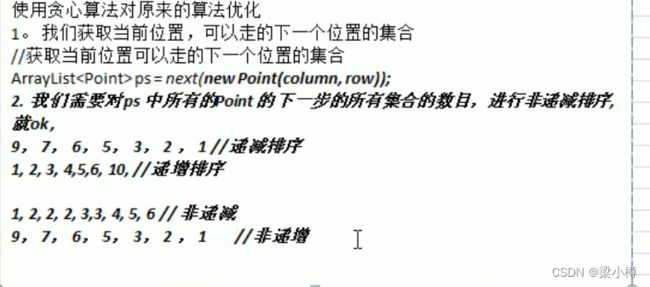骑士周游算法(Java)
目录
-
- 第9章 骑士周游问题
-
- 9.1 马踏棋盘游戏
- 9.2 骑士周游回溯算法简介
- 9.3 代码实现
- 本次骑士周游算法算法 的教程出自韩顺平的数据结构与算法
第9章 骑士周游问题
9.1 马踏棋盘游戏
1)马踏棋盘算法也被称为骑士周游问题
2)将马随机放在国际象棋的8*8棋盘上Board[0~7] [0~7]的某个方格中,马按照走棋规则(马走日字)进行移动。要求每个方格只进行一次,走遍棋盘上全部64各方格
9.2 骑士周游回溯算法简介
1)马踏棋盘(骑士周游问题)实际上是图的深度优先搜索(DFS)的应用
2)如果使用回溯(深度优先搜索)来解决,假如马走了53个点,如图:坐标(1,0)发现已经走到尽头,没有办法继续回退,查看其他路径,就在棋盘上不停的回溯,
3)分析第一种方式的问题,使用贪心算法(greedyAlgorithm)进行优化,解决马踏棋盘问题
9.3 代码实现
package com.ldm.horse;
import java.awt.*;
import java.util.ArrayList;
/**
* @author 梁东明
* 2022/9/15
* 人生建议:看不懂的方法或者类记得CTRL + 点击 看看源码或者注解
* 点击setting在Editor 的File and Code Templates 修改
*/
public class HorseChessBoard {
private static int X; //棋盘的列数
private static int Y; //棋盘的行数
//创建一个数组,标记棋盘的各个位置是否被访问过
private static boolean visited[];
//使用一个属性,标记是否棋盘的所有位置都被访问
private static boolean finished; // 如果为true,表示成功
public static void main(String[] args) {
System.out.println("骑士周游算法,开始运行~~");
//测试骑士周游算法是否正确
X = 8;
Y = 8;
int row = 1; //马儿初始位置的行,从1开始编号
int column = 1; //马儿初始位置的列,从1开始编号
//创建棋盘
int[][] chessBoard = new int[X][Y];
visited = new boolean[X*Y];
//测试一下耗时
long start = System.currentTimeMillis();
traverSalChessBoard(chessBoard,row-1,column-1,1);
long end = System.currentTimeMillis();
System.out.println("总耗时="+(end-start)+" 毫秒");
//输出棋盘的情况
for (int[] rows : chessBoard) {
for (int step : rows) {
System.out.print(step +"\t");
}
System.out.println();
}
}
/**
* 骑士周游算法实现
*
* @param chess 棋盘
* @param row 马当前的位置的行 从0开始
* @param column 马当前的位置的列 从0开始
* @param step 第几步,初始是第一步
*/
public static void traverSalChessBoard(int[][] chess, int row, int column, int step){
//把传入的第一个点蛇者为第一步
chess[row][column] = step;
visited[row*X+column] = true; //标记该位置已经访问
//获取当前位置可以走下一个位置的集合
ArrayList<Point> ps = next(new Point(row, column));
//遍历ps
while ( !ps.isEmpty()){
Point remove = ps.remove(0); //取出下个可以走的位置
//判断该点是否被访问过
if (!visited[remove.x*X+remove.y]){
//回溯(递归)
traverSalChessBoard(chess, remove.x, remove.y, step+1);
}
}
//判断马儿是否完成了任务,使用 step 和应该走的步数比较 ,
//如果没有达到数量,则表示没有完成任务,将整个棋盘置0
//说明: step < X * Y 成立的情况有两种
//1. 棋盘到目前位置,仍然没有走完
//2. 棋盘处于一个回溯过程
if ( step < X*Y && !finished){
chess[row][column] = 0;
visited[row*X+column] = false;
}else {
finished = true;
}
}
/**
* 功能: 根据当前位置(Point对象),计算马儿还能走哪些位置(Point)
* 并放入到一个集合中(ArrayList), 最多有8个位置
* @param curPoint
* @return
*/
public static ArrayList<Point> next(Point curPoint){
//创建一个ArrayList
ArrayList<Point> ps = new ArrayList<>();
//创建一个Point
Point p1 = new Point();
//表示马儿可以走5这个位置
if((p1.x = curPoint.x - 2) >= 0 && (p1.y = curPoint.y -1) >= 0) {
ps.add(new Point(p1));
}
//判断马儿可以走6这个位置
if((p1.x = curPoint.x - 1) >=0 && (p1.y=curPoint.y-2)>=0) {
ps.add(new Point(p1));
}
//判断马儿可以走7这个位置
if ((p1.x = curPoint.x + 1) < X && (p1.y = curPoint.y - 2) >= 0) {
ps.add(new Point(p1));
}
//判断马儿可以走0这个位置
if ((p1.x = curPoint.x + 2) < X && (p1.y = curPoint.y - 1) >= 0) {
ps.add(new Point(p1));
}
//判断马儿可以走1这个位置
if ((p1.x = curPoint.x + 2) < X && (p1.y = curPoint.y + 1) < Y) {
ps.add(new Point(p1));
}
//判断马儿可以走2这个位置
if ((p1.x = curPoint.x + 1) < X && (p1.y = curPoint.y + 2) < Y) {
ps.add(new Point(p1));
}
//判断马儿可以走3这个位置
if ((p1.x = curPoint.x - 1) >= 0 && (p1.y = curPoint.y + 2) < Y) {
ps.add(new Point(p1));
}
//判断马儿可以走4这个位置
if ((p1.x = curPoint.x - 2) >= 0 && (p1.y = curPoint.y + 1) < Y) {
ps.add(new Point(p1));
}
return ps;
}
}
package com.ldm.horse;
import java.awt.*;
import java.util.ArrayList;
import java.util.Comparator;
/**
* @author 梁东明
* 2022/9/15
* 人生建议:看不懂的方法或者类记得CTRL + 点击 看看源码或者注解
* 点击setting在Editor 的File and Code Templates 修改
*/
public class HorseChessBoard {
private static int X; //棋盘的列数
private static int Y; //棋盘的行数
//创建一个数组,标记棋盘的各个位置是否被访问过
private static boolean visited[];
//使用一个属性,标记是否棋盘的所有位置都被访问
private static boolean finished; // 如果为true,表示成功
public static void main(String[] args) {
System.out.println("骑士周游算法,开始运行~~");
//测试骑士周游算法是否正确
X = 8;
Y = 8;
int row = 1; //马儿初始位置的行,从1开始编号
int column = 1; //马儿初始位置的列,从1开始编号
//创建棋盘
int[][] chessBoard = new int[X][Y];
visited = new boolean[X*Y];
//测试一下耗时
long start = System.currentTimeMillis();
traverSalChessBoard(chessBoard,row-1,column-1,1);
long end = System.currentTimeMillis();
System.out.println("总耗时="+(end-start)+" 毫秒");
//输出棋盘的情况
for (int[] rows : chessBoard) {
for (int step : rows) {
System.out.print(step +"\t");
}
System.out.println();
}
}
/**
* 骑士周游算法实现
*
* @param chess 棋盘
* @param row 马当前的位置的行 从0开始
* @param column 马当前的位置的列 从0开始
* @param step 第几步,初始是第一步
*/
public static void traverSalChessBoard(int[][] chess, int row, int column, int step){
//把传入的第一个点蛇者为第一步
chess[row][column] = step;
visited[row*X+column] = true; //标记该位置已经访问
//获取当前位置可以走下一个位置的集合
ArrayList<Point> ps = next(new Point(row, column));
//对ps进行排序,排序的规则就是对ps的所有的Point对象的下一步的位置的数目,进行非递减排序
sort(ps);
//遍历ps
while ( !ps.isEmpty()){
Point remove = ps.remove(0); //取出下个可以走的位置
//判断该点是否被访问过
if (!visited[remove.x*X+remove.y]){
//回溯(递归)
traverSalChessBoard(chess, remove.x, remove.y, step+1);
}
}
//判断马儿是否完成了任务,使用 step 和应该走的步数比较 ,
//如果没有达到数量,则表示没有完成任务,将整个棋盘置0
//说明: step < X * Y 成立的情况有两种
//1. 棋盘到目前位置,仍然没有走完
//2. 棋盘处于一个回溯过程
if ( step < X*Y && !finished){
chess[row][column] = 0;
visited[row*X+column] = false;
}else {
finished = true;
}
}
/**
* 功能: 根据当前位置(Point对象),计算马儿还能走哪些位置(Point)
* 并放入到一个集合中(ArrayList), 最多有8个位置
* @param curPoint
* @return
*/
public static ArrayList<Point> next(Point curPoint){
//创建一个ArrayList
ArrayList<Point> ps = new ArrayList<>();
//创建一个Point
Point p1 = new Point();
//表示马儿可以走5这个位置
if((p1.x = curPoint.x - 2) >= 0 && (p1.y = curPoint.y -1) >= 0) {
ps.add(new Point(p1));
}
//判断马儿可以走6这个位置
if((p1.x = curPoint.x - 1) >=0 && (p1.y=curPoint.y-2)>=0) {
ps.add(new Point(p1));
}
//判断马儿可以走7这个位置
if ((p1.x = curPoint.x + 1) < X && (p1.y = curPoint.y - 2) >= 0) {
ps.add(new Point(p1));
}
//判断马儿可以走0这个位置
if ((p1.x = curPoint.x + 2) < X && (p1.y = curPoint.y - 1) >= 0) {
ps.add(new Point(p1));
}
//判断马儿可以走1这个位置
if ((p1.x = curPoint.x + 2) < X && (p1.y = curPoint.y + 1) < Y) {
ps.add(new Point(p1));
}
//判断马儿可以走2这个位置
if ((p1.x = curPoint.x + 1) < X && (p1.y = curPoint.y + 2) < Y) {
ps.add(new Point(p1));
}
//判断马儿可以走3这个位置
if ((p1.x = curPoint.x - 1) >= 0 && (p1.y = curPoint.y + 2) < Y) {
ps.add(new Point(p1));
}
//判断马儿可以走4这个位置
if ((p1.x = curPoint.x - 2) >= 0 && (p1.y = curPoint.y + 1) < Y) {
ps.add(new Point(p1));
}
return ps;
}
//根据当前这个一步的所有的下一步的选择位置,进行非递减排序, 减少回溯的次数
public static void sort(ArrayList<Point> ps){
ps.sort(new Comparator<Point>() {
@Override
public int compare(Point o1, Point o2) {
//先获取o1的下一步的位置个数
int count1 = next(o1).size();
//再获取o2的下一步的位置个数
int count2 = next(o2).size();
if ( count1 < count2 ){
return -1;
}else if ( count1 == count2){
return 0;
}else {
return 1;
}
}
});
}
}
本次骑士周游算法算法 的教程出自韩顺平的数据结构与算法
数据结构和算法教程,哔哩哔哩详细教程
在 189-194p.
相信有不少朋友是从B站过来的吧!我在弹幕里承诺过会把韩老师的数据结构与算法系列全部更新,2022.8.18开始,中途因为中秋回家休息两天,到2022.9.15结束,每天花5、6个小时看完8个视频左右,跟着老师敲代码。今天终于更新完了。很不舍得,要和大家分别啦!我的数据结构系列文章是按照韩老师的教学基础下,增加了我自己大量的心血,因为教程是三年前的,还是用eclipse写的(我的使用idea)所以韩老师的代码不免在细节上有挺多的瑕疵,我都一一在自己系列文章中加以改正,添加我自己的注解以及建议。以及很多idea快捷键的使用技巧。到现在我都不敢相信我真的坚持下来了,所以很想说一句:希望大家以后在学习的路上能一直坚持,借用韩老师的桌面名言:除非我不想赢,不然没人能让我输
这里是我学习数据结构的全部笔记和代码(使用idea编辑器写的)。大家有兴趣的可以下载来参考

点击下载
最后,认识一下,我是小白。努力成为一名合格的程序员。期待与你的下次相遇




